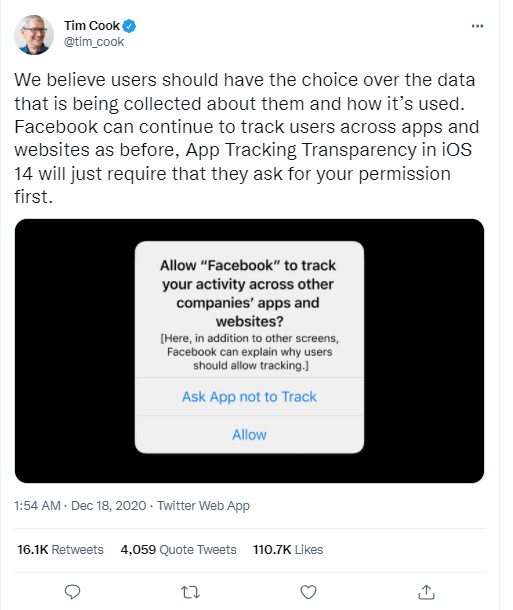MMM cookies! I love the chocolate chip ones that you dip in your coffee. Sadly, I’m not talking about that kind of cookie today. We are talking, digital cookies. The end of the cookie era is a big deal for brands. Third-party cookies have long been a powerful enabler of the commercial internet, allowing for highly specific ad targeting. Many big browsers are already blocking third-party cookies and Google is set to end third-party cookie support in 2023. With the complete end of third-party cookies almost upon us, how will brands (including yours) be affected?
What is a cookie?
A cookie is a small text file containing information – such as a username and password – that is placed on a user’s computer, via their browser, by a server. A cookie identifies a user and their preferences, like what email address they use to log in to a site.
What are cookies used for?
There are three main types of cookies. These are session, persistent, and third-party.
- Session cookies are cookies that expire as soon as the user leaves a site.
- Persistent cookies (sometimes called ‘permanent cookies’) are stored on a user’s computer so that they can be used again the next time they visit a site.
- Third-party cookies are cookies that do not originate from the website a user is visiting – they come from third parties i.e. other sites or domains. Third-party cookies usually occur when a site incorporates elements from other sites, like advertising or even social media plugins and images. When a user’s browser fetches these elements from other sites, they can (or at least they could) set cookies too.
The type of cookies that are ending is third-party cookies. These cookies have been used for over two decades by advertisers to serve relevant ads to users based on their past browsing history. For example, if a user already visited an online bridal services shop, they’re more likely to be interested in bridal services ads displayed on other websites. This is how advertisers use cookies to their advantage. You’ve almost surely had third-party cookie ads target you at some point. You browse Amazon for cat beds and suddenly you see ads for cat beds all over the web; that’s the work of third-party cookies.
History of third-party cookie phase-out
The GDPR and the ePrivacy Directive (together informally known as the Cookie Law) are critically important laws designed to protect personal data and privacy. Although these are EU laws, they have (and will continue to) affect brands across the globe. This is because these laws also apply to brands that are based outside of the EU but that have customers or users that are in the EU.
The ePrivacy Directive has been in effect since 2002 and includes guidelines and expectations of sites to respect users’ privacy, including email marketing and the use of cookies. It’s still in effect today and is complementary to the GDPR. The GDPR (General Data Protection Regulation) came into effect in 2018. It lays out how personal data should be lawfully processed which includes data collected via cookies.
The EU’s Cookie Law is not a cookie ban but a cookie restriction. Sites in the EU can still use cookies but they first need to obtain permission from their users. You’re almost undoubtedly familiar with those small (sometimes slightly annoying) pop-up messages telling you that the site you’re visiting uses cookies. This all started with the EU’s regulations.
On top of this, Google, Apple, and Mozilla are at the forefront of ensuring that their users have a third-party cookie-free experience. Google made an announcement in January of 2020 that it would eliminate third-party cookies from its Chrome browser by 2022 (although this has now been tentatively extended to the end of 2023). Apple’s Safari already blocks all third-party cookies by default, as does Mozilla’s Firefox.
Why are third-party cookies ending?

The push to end third-party cookies is down to users’ growing distrust of them and higher regard for online privacy. Here’s an example of just how infringed upon third-party cookies can make users feel: Your kid’s birthday is coming up and after doing some pretty extensive research on Amazon, you settle on the Fortnite Series 1 Skull Trooper 7-Inch Deluxe Action Figure. Later that day, your kid borrows your tablet to get their homework done. As they browse, they come across multiple ads for Fortnite figurines. They ask you if they could perhaps get one for their birthday (it is coming up after all). The surprise is ruined.
Darker stories emerged of searches pertaining to confidential or sensitive medical information that then retargets you across the web and social media.
Third-party cookies are created by domains separate from the site that you are visiting, often without the user even being aware that a cookie has been created. Although users may see more relevant content with the help of third-party cookies, they don’t necessarily want this and this type of cookie has increasingly been seen as intrusive rather than helpful.
What does this mean for marketers?
Many advertising sectors are heavily reliant on third-party cookies. The use of these cookies has allowed advertisers to, among other things, retarget their ads to consumers based upon their previous searches and browsing history. Without cookies, the ability to target consumers in this way will be impossible. The end of third-party cookies means that marketers are going to need to rethink how they generate leads.
It’s critical that you review your brand’s dependence on third-party cookies. Meticulously document exactly where and to what degree your brand’s current practices depend on third-party cookies. Do the same with all of your brand’s partners – document which heavily rely on third-party cookies, which exclusively utilise first-party data, and which use a mix of data sources to generate leads. When third-party cookies are entirely eliminated in the not-so-distant future, you don’t want to suffer drops in leads because your partners weren’t prepared.
Remember, cookies aren’t only used to secure new leads. They also play roles in plenty of analytical tools. Determine which tools your brand relies on and how these will be affected by the death of third-party cookies. Don’t forget to do the same for your brand’s own tools too – tools used for user personalisation on your site and in email marketing can also be affected by third-party cookies.
Facebook V Apple
Whilst not directly relating to web cookies, the Facebook V Apple dispute underscores a fundamental shift in privacy rules.
The iPhone maker rolled out an update to its operating system that prompts you to give apps permission to track their activity across other apps and the web. Apple calls this change App Tracking Transparency. Facebook, however, has been fuming about the change, which threatens the source of its $86 billion in annual revenue: targeted ads. The social network waged a months-long campaign against Apple, running full-page ads in national newspapers and testing pop-ups inside the Facebook app to encourage users to accept its tracking. It was all fairly petty and its safe to say there are no “good guys” in this fight!

So, what’s next?
Alternative routes to third-party cookies are already in use by most established brands and sites. If your brand heavily relies on third-party cookies to create new leads, it’s strongly recommended that you re-evaluate the way your marketing efforts are carried out. Things to consider:
First-party cookies
While third-party cookies are quickly disappearing from the web, first-party cookies are not. In fact, Google has described first-party relationships between brands and customers as ‘vital’. First-party cookies refer to cookies that store customer info directly to the site they’re visiting. Brands should be using these cookies to their advantage to gain data from their users so that they can provide their customers with a more seamless experience but also gather data that can help secure further conversions.
Use first-party cookies to:
- Remember user preferences like login details and language settings – The less time your customers have to worry about remembering which email they use for your site, how to change language settings and so on, the more time they can spend getting the most out of your site (which means more sales).
- Analyse user behaviour – Using first-party cookies, you’re able to track what people do on your site. You’ll be able to see how long they stayed, where they came from, which keywords they searched for to find you, how many pages of your site they looked at and what they were, if they subscribed to something or purchased something, and tons more. This data is incredibly useful for retargeting users later.
- Present personalised content to your users – Using the data you gathered from first-party cookies, you can then design personalised retargeting campaigns for your existing leads and customers. You can also use the data to suggest add-on products, similarly to how Amazon asks their users if they’d like to buy additional batteries for the camera the shopper is about to purchase.
- Determine which aspects of your site are working…and which aren’t – Since you can see which pages users spend longer on, which they interact with the most, and which they bounce from, you can get a pretty good picture of the aspects of your site that are engaging users the most. Evaluate why you think certain pages are working better than others and try to transfer their qualities to other less well-performing pages.
Google’s Privacy Sandbox
One of the most intriguing responses to the end of third-party cookies is Google’s Privacy Sandbox. Google describe it as a way to ‘create a thriving web ecosystem that is respectful of users and private by default’. This technology is still under development and Google have yet to announce a firm release date but they say they are aiming to have it deployed by late 2022.

Privacy Sandbox will work, in a way, quite similarly to third-party cookies except that all the data on users will be gathered by Google first-hand, without tracking users across the web and whilst users remain anonymous. The data will allow Google to create user profiles that can indicate what sort of ads particular users may be more interested in. Definitely stay in the know about developments to Privacy Sandbox so that your brand can take advantage of it in the near future.
Contextual marketing
Contextual ads are a type of targeted advertising that don’t depend on third-party cookies to get your message to users with relevant interests and buying priorities. Your ads are matched to sites based on content rather than cookies. Using contextual marketing, your ads can appear on sites that are relevant to your brand’s niche. This is achieved through matching similar site keywords to your own. These ads are typically PPC. Contextual targeting works based on the assumption that someone reading a page about running is likely to also be interested in your ad for sneakers.

Content marketing
While already a mainstay in the majority of established brands’ marketing schemes, content marketing is only set to further grow. In fact, 82% of marketers report actively using content marketing in 2021, up 70% from the previous year. And, 72% confirm content marketing increases engagement and lead generation.
Publishing content on your brand’s blog that is well-written, unique, and genuinely helpful can help you rank highly on search engines and bring in substantial traffic. However, the challenge of this sort of inbound marketing approach is the time and resources it can occupy. Producing up-to-date and relevant content consistently is no easy feat. Learn more about what goes into an ideal content marketing strategy here. Or, simply get in touch with Contentworks to discuss content marketing for your brand.
As a side note, we use organic content marketing for our own agency and the results are consistently impressive.

What’s the future of online marketing?
The future of cookies is a matter of importance and will determine the way we do online marketing. But in a more general sense, marketers also need to be on top of general attitudes towards online privacy and be prepared to make changes to their strategies as new regulations and changing user preferences develop. Brands looking to adapt to the future of digital marketing should consider other means of securing leads and analysing user behaviour.
Third-party cookies are all but a thing of the past. The EU’s regulations were a catalyst for the end of the cookie era, and with all major browsers already blocking, or planning to block them imminently, third-party cookies are definitively and swiftly on the way out.
Brands should no longer invest in any third-party cookie marketing schemes – although Google may still allow this type of cookie (for now), consumer attitudes towards this style of advertising are not favourable. Users don’t want to trade their privacy for what marketers decide is ‘relevant’ ad retargeting. Any brand looking to position itself as a reputable company in its sector should avoid third-party cookies entirely.
Marketers should now be looking at alternatives to third-party cookie marketing. They should update their platforms and marketing campaigns to take advantage of strategies such as the nurturing of first-party data, contextual marketing, and of course my tried and tested favourite, content marketing.
Found this article interesting? Share Cookies Are Ending – What Does It Mean for Your Brand? with your audience. Made it to the end? Tell me your favourite type of cookie – mine is white choc with cranberries 🙂